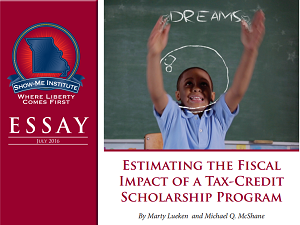Last year, Missouri was one of 18 states that introduced legislation to create an education savings account (ESA) program for families. While it didn’t ultimately become law, it’s stoked the conversation about educational choice in the state and how we can empower families to find schooling options that work for their kids.
 Under an ESA program, state officials deposit money into an account for education expenses for children who sign up for the plan. Parents can spend the money on a host of education expenses ranging from books to special needs services, online education, tutoring, SAT and ACT preparation or private school tuition. Parents can also roll over unused funds and use them in the future to pay for college tuition.
Under an ESA program, state officials deposit money into an account for education expenses for children who sign up for the plan. Parents can spend the money on a host of education expenses ranging from books to special needs services, online education, tutoring, SAT and ACT preparation or private school tuition. Parents can also roll over unused funds and use them in the future to pay for college tuition.
Currently, there are five K-12 ESA programs operating in five states – Arizona, Florida, Mississippi, Nevada, and Tennessee.
ESAs are a new and promising innovation with lots of potential because they move beyond just giving parents a say in what school their children attend. ESAs empower parents to tailor an educational experience that they want for their own children.
In essence, it expands on what Nobel Laureate and economist Milton Friedman’s vision of providing parents with freedom to choose the school that best suits their children’s needs. Going a step further, ESAs allow parents to unbundle educational goods and services and choose the ones that best meet their needs. School choice is getting an upgrade.
Critics of ESAs and other school choice efforts like to allege that the programs will “siphon” resources from public schools or harm students in some way. Fortunately, school choice has been around long enough to have produced a large body of research to learn from.
Researcher Greg Forster, for instance, systematically reviewed 100 studies. His findings: school choice affects all of these areas mentioned above in a positive way. Students who choose score higher in reading and math, are more likely to graduate and are more likely to succeed in college. They also are more likely to learn civic values. Moreover, increased competition from school choice makes students remaining in public schools better off. When students choose, schools also tend to become more integrated. And not a single study found that school choice cost taxpayers any money.
Although greater educational freedom for Missouri families would be reason enough for many to adopt a program, some, including taxpayers and legislators, want to know how an ESA program would affect the state’s bottom line – a legitimate concern. A paper I recently co-authored with Mike McShane, Director of Education Policy at the Show-Me Institute, estimated the fiscal impact of a broad-eligibility ESA program on Missouri taxpayers and public school districts. This program would be funded by tax credits for private donations, in which nearly all Missouri K-12 age children (88 percent) would be eligible. We considered a program that is capped at $50 million in its first year, which is a drop in Missouri’s $5.7 billion K-12 education budget’s bucket.
Using a variety of circumstances to make our estimates, we found that state government and local school districts combined would save between $8 million and $58 million per year under an ESA program. The school districts alone would save $21 million to $40 million per year. The state – which is footing the bill by issuing tax credits – could save up to $18 million annually.
What does this mean? For starters, public school districts would have more resources for each student who remains in public school (as well as other tangential benefits such as smaller class sizes and better matches between Missouri students and schools).
Overall, however, Missourians and their children would have little to worry about and a whole lot to gain. The Show-Me State has tried many things to improve their schools, especially in the areas that struggle the most, with little success. It’s time to go bold, and try something that’s already a demonstrated success. It’s time for Missouri to create an education system fit for the future.
– Martin Lueken
Martin F. Lueken, Ph.D. is the Director of Fiscal Policy and Analysis at the Friedman Foundation for Educational Choice. This article was originally posted on Jay P. Greene’s Blog.


